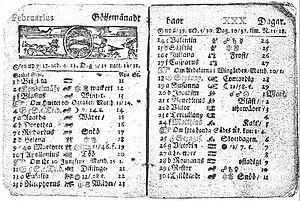List of non-standard dates

Several non-standard dates are used in calendars for various purposes: some are expressly fictional, some are intended to produce a rhetorical effect (such as sarcasm), and others attempt to address a particular mathematical, scientific or accounting requirement or discrepancy within the calendar system.
Historical
[edit]January 0
[edit]January 0 or 0 January is an alternative name for December 31. January 0 is the day before January 1 in an annual ephemeris. It keeps the date in the year for which the ephemeris was published, thus avoiding any reference to the previous year, even though it is the same day as December 31 of the previous year. January 0 also occurs in the epoch for the ephemeris second, "1900 January 0 at 12 hours ephemeris time".[1] 1900 January 0 (at Greenwich Mean Noon) was also the epoch used by Newcomb's Tables of the Sun, which became the epoch for the Dublin Julian day.[2]
February 30
[edit]
February 30 or 30 February is a date that does not occur on the Gregorian calendar, where the month of February contains only 28 days, or 29 days in a leap year. However, from a historical perspective February 30 has been used at least once and appears in some reform calendars.
The thirteenth-century scholar Johannes de Sacrobosco claimed that in the Julian calendar, February had 30 days in leap years from 45 BC until 8 BC, when Augustus allegedly shortened February by one day to give that day to the month of August named after him so that it had the same length as the month of July named after his adoptive father, Julius Caesar. However, all historical evidence refutes Sacrobosco, including dual dates with the Alexandrian calendar.[3]
February 30 was a day that happened in Sweden, 1712.[4] This occurred because, instead of changing from the Julian calendar to the Gregorian calendar by omitting a block of consecutive days, as had been done in other countries, the Swedish Empire planned to change gradually by omitting all leap days from 1700 to 1740, inclusive. Although the leap day was omitted in February 1700, the Great Northern War began later that year, diverting the attention of the Swedes from their calendar so that they did not omit leap days on the next two occasions; 1704 and 1708 remained leap years.[5]
To avoid confusion and further mistakes, the Julian calendar was restored in 1712 by adding an extra leap day, thus giving that year the only known actual use of February 30 in a calendar. That day corresponded to February 29 in the Julian calendar and to March 11 in the Gregorian calendar.[5][6] The Swedish conversion to the Gregorian calendar was finally accomplished in 1753, when February 17 was followed by March 1.[5]
Artificial calendars may also have 30 days in February. For example, in a climate model the statistics may be simplified by having 12 months of 30 days. The Hadley Centre General Circulation Model is an example.[7]
February 31
[edit]February 31 or 31 February is exceptionally used on gravestones when the date is unknown,[8][better source needed] or, in at least one case, out of supposed superstition (more likely an error).[9][10]
May 35
[edit]May 35 or 35 May is used in mainland China to avoid censorship when referring to the Tiananmen Square protests of 1989, where the official names are strictly censored by the national government, and the event is normally referred to as June 4.[11] It is also used in the title of The 35th of May, or Conrad's Ride to the South Seas, a German children's novel published in 1931.
July 36
[edit]July 36 refers to 5 August 2024, when the Bangladesh quota reform movement celebrated Prime Minister Sheikh Hasina resigning and fleeing to India after mass protests, which began with the reinstatement of the quota system in June and escalated despite the Supreme Court's ruling on 21 July in favor of quota reform.[12][13][14]
December 31.5 GMT
[edit]December 31.5 GMT in 1924 almanacs was an instant defined to resolve the contrast between two different conventions in defining the civil time of referring to midnight as zero hours.[15]
December 32, 1980
[edit]The LearAvia Lear Fan aircraft test flight had British government "funding that expired at the end of that year." After the cancellation of a planned test flight on December 31, 1980, due to technical issues, the first prototype made its maiden flight on January 1, 1981, but a sympathetic government official recorded the date as "December 32, 1980".[16]
Software
[edit]Microsoft Excel displays the day before January 1, 1900 (the earliest date it can represent) as January 0, 1900.[17] It also treats 1900 incorrectly as a leap year (whereas only centuries divisible by 400 are), so it displays the day before March 1, 1900 as the non-existent February 29 instead of February 28. This means March 1, 1900 is the earliest date that can be used reliably in Excel.
February 31 is used (along with February 32 and February 33) for calculating weather data.[18][19]
Other non-standard dates are sometimes used in software engineering. For example, Java (specifically the java.util.Calendar class) allows dates such as February 0 (= January 31) and April 31 (= May 1).
Other uses
[edit]March 0 is used in astronomy.[20] [clarification needed]
Fictional calendars
[edit]In the works of J. R. R. Tolkien, the Hobbits have developed the Shire Reckoning. According to Appendix D of The Lord of the Rings, this calendar has arranged the year in 12 months of 30 days each. The month the Hobbits call Solmath is rendered in the text as February, and therefore the date February 30 exists in the narrative.[21]
February 30, 1951, is the last night of the world in Ray Bradbury's short story "Last Night of the World".[22]
June 31 is a fictional date in the Soviet film 31 June. It is also the date of a fictional RAF raid on Germany in Len Deighton's 1970 novel Bomber.
December 32 or 32 December is the date of Hogswatchnight in Hogfather by Terry Pratchett. It has also been used as a title for various works.
The children's book Please Try to Remember the First of Octember! by Dr. Seuss narrates many delightful things which are supposed to happen starting on the first day of the fictional month of Octember.
In popular culture
[edit]
March 0 is used in Doomsday algorithm calculations.[23] March 2 was celebrated as February 30 by Lin-Manuel Miranda and Weird Al Yankovic for the release date of Yankovic's "The Hamilton Polka".[24]
In November 2010 it was discovered that a Hanshin Tigers wall calendar incorrectly included the date November 31. Fans who had bought the calendar were given a sticker to cover up the date, and reprinted calendars were sent.[25]
In the episode "94 Meetings" of the sitcom Parks and Recreation, Ron Swanson is forced to deal with 94 meetings in a single day because his assistant, April, scheduled them all for March 31st (instead of the common fake date of February 31st), mistakenly believing it was not a real date.
Soul band Black Pumas included a song named "OCT 33" on their Grammy-nominated 2019 eponymous album.
The 1998 French-language film August 32nd on Earth was written and directed by Denis Villeneuve, and was his feature film directoral debut.
In Bangladeshi popular culture, August 5, 2024 was celebrated as July 36, when Prime minister Sheikh Hasina resigned and fled the country amid the mass uprising, in remembrance of those died in the students' job quota reform movement on the month of July 2024.
Reform calendars
[edit]Because evening out the lengths of the months is part of the rationale for reforming the calendar, some reform calendars, such as the World Calendar and the Hanke–Henry Permanent Calendar, contain a 30-day February. The Symmetry454 calendar assigns 35 days to February, May, August, and November, as well as December in a leap year.
See also
[edit]- Ides of March
- List of calendars
- Time formatting and storage bugs
- System time
- Tibb's Eve, a day said to occur neither before nor after Christmas
- Undecimber
References
[edit]- ^ "Leap Seconds". Time Service Department, United States Naval Observatory. Archived from the original on February 28, 2012. Retrieved December 31, 2006.
- ^ Ransom, David H. Jr. (November 19, 1989). "Program ASTROCLK: Astronomical Clock and Celestial Tracking Program with Celestial Navigation". p. 110.
- ^ Roscoe Lamont, "The Roman calendar and its reformation by Julius Caesar", Popular Astronomy 27 (1919) 583–595. Sacrobosco's theory is discussed on pages 585–587.
- ^ Hocken, Vigdis. "February 30 Was a Real Date". timeanddate.com. Archived from the original on March 29, 2024. Retrieved July 11, 2024.
- ^ a b c Bauer, R. W. (1868). Calender for Aarene fra 601 til 2200. Copenhagen, Denmark: Dansk Historisk Fællesråd (1993 reprint). p. 100. ISBN 87-7423-083-2.
- ^ Vallerius, Johannes (1711). Allmanach på åhret effter Christi födelse 1712. Lund, Sweden.
- ^ "Hadley Centre: GDT netCDF conventions". MetOffice.com. November 22, 2005. Archived from the original on November 22, 2005. Retrieved March 21, 2017.
- ^ "February 31 On Gravestone". Swampy Acres Farm Blog. December 19, 2018. Archived from the original on December 19, 2018. Retrieved June 13, 2019.
- ^ Troy Taylor (2005). Weird Illinois. Sterling Publishing Co., Inc. p. 212. ISBN 9780760759431.
- ^ McBride Jacobson, Molly (January 6, 2017). "St. Omer Cemetery Witch Grave". Atlas Obscura.
- ^ "China tightens information controls for Tiananmen anniversary". The Age. Australia. Agence France-Presse. June 4, 2009. Retrieved November 3, 2010.
- ^ "'Bangladesh Reborn: Pathway to July 36' photo exhibition by BJIM starts tomorrow". The Business Standard. December 1, 2024. Retrieved December 4, 2024.
- ^ "Photo exhibition 'Saluting the Brave Hearts, 36 days of July' inaugurated". Dhaka Tribune. Retrieved December 4, 2024.
- ^ "'New Bangladesh', '36 July': Artworks grow on Dhaka walls to memorialise protests". Mid-day. August 20, 2024. Retrieved December 4, 2024.
- ^ Astronomical Supplement to the Astronomical Almanac. University Science Books. 1992. p. 76. ISBN 0-935702-68-7.
- ^ "Lear Fan 2100 (Futura)". The Museum of Flight. 2009. Archived from the original on July 12, 2009. Retrieved November 27, 2009.
- ^ Lowe, Scott (May 11, 2007). "How do I... Perform basic formatting in Excel 2003?". TechRepublic.
- ^ Everett, J. D. (January 1, 1863). "Description of a method of reducing observations of temperature". American Journal of Science. s2-35 (103): 17–31. Bibcode:1863AmJS...35...17E. doi:10.2475/ajs.s2-35.103.17. S2CID 130637323.
- ^ Tjia, John S. (2009). Building Financial Models. McGraw Hill Professional. p. 144. ISBN 978-0-07-160890-9.
- ^ The Astronomical Almanac for the Year 2003: Data for Astronomy, Space Sciences, Geodesy, Surveying, Navigation and Other Applications. U.S. Government Printing Office. 2001. p. K2. Bibcode:2001asal.book.....U. ISBN 978-0-11-887320-8.
- ^ Tolkien, J. R. R. (1965). "Appendix D". The Return of the King (2nd ed.). Boston: Houghton Mifflin Co. ISBN 978-0-395-08256-0.
- ^ "A Classic Ray Bradbury Esquire Story". esquire.com. June 6, 2012. Retrieved March 21, 2017.
- ^ Graham, S. W. (July 1995). "The Doomsday Rule". people.se.cmich.edu. Retrieved April 1, 2023.
- ^ Greene, Andy (March 2, 2018). "Lin-Manuel Miranda, 'Weird Al' Yankovic Talk New 'Hamilton Polka'". Rolling Stone. Retrieved March 2, 2018.
- ^ "阪神タイガース、来年のカレンダーに". Nikkei (in Japanese). November 28, 2010. Archived from the original on February 27, 2019. Retrieved December 13, 2023.
- The Oxford Companion to the Year. Bonnie Blackburn & Leofranc Holford-Strevens. Oxford University Press 1999. ISBN 0-19-214231-3. pp. 98–99.
